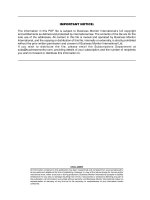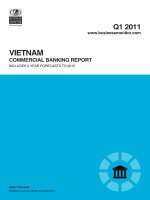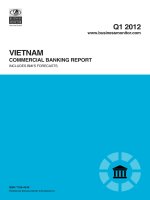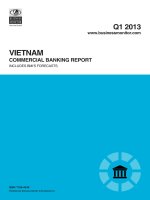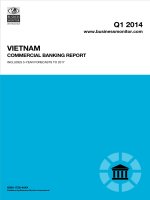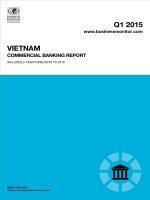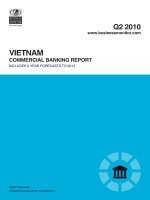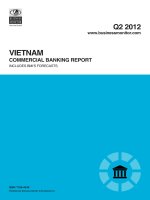Vietnam commercial banking report q4 2012
Bạn đang xem bản rút gọn của tài liệu. Xem và tải ngay bản đầy đủ của tài liệu tại đây (496.31 KB, 63 trang )
Q4 2012
www.businessmonitor.com
COMMERCIAL BANKING REPORT
ISSN 1758-454X
Published by Business Monitor International Ltd.
VIETNAM
INCLUDES BMI'S FORECASTS
Business Monitor International
85 Queen Victoria Street
London
EC4V 4AB
UK
Tel: +44 (0) 20 7248 0468
Fax: +44 (0) 20 7248 0467
Email:
Web: www.businessmonitor.com
© 2012 Business Monitor International.
All rights reserved.
All information contained in this publication is
copyrighted in the name of Business Monitor
International, and as such no part of this publication
may be reproduced, repackaged, redistributed, resold in
whole or in any part, or used in any form or by any
means graphic, electronic or mechanical, including
photocopying, recording, taping, or by information
storage or retrieval, or by any other means, without the
express written consent of the publisher.
DISCLAIMER
All information contained in this publication has been researched and compiled from sources believed to be accurate and reliable at the time of
publishing. However, in view of the natural scope for human and/or mechanical error, either at source or during production, Business Monitor
International accepts no liability whatsoever for any loss or damage resulting from errors, inaccuracies or omissions affecting any part of the
publication. All information is provided without warranty, and Business Monitor International makes no representation of warranty of any kind as
to the accuracy or completeness of any information hereto contained.
VIETNAM COMMERCIAL
BANKING REPORT Q4 2012
INCLUDES 5-YEAR FORECASTS TO 2016
Part of BMI’s Report & Forecasts Series
Published by: Business Monitor International
Copy deadline: September 2012
Vietnam Commercial Banking Report Q4 2012
© Business Monitor International Ltd Page 2
Vietnam Commercial Banking Report Q4 2012
© Business Monitor International Ltd Page 3
CONTENTS
Executive Summary 5
Table: Levels (VNDbn) 5
Table: Levels (US$bn) 5
Table: Levels At February 2012 5
Table: Annual Growth Rate Projections 2012-2016 (%) 5
Table: Ranking Out Of 59 Countries Reviewed In 2011 6
Table: Projected Levels (VNDbn), 2009-2016 6
Table: Projected Levels (US$bn), 2009-2016 6
SWOT Analysis 7
Vietnam Commercial Banking SWOT 7
Vietnam Political SWOT 7
Vietnam Economic SWOT 8
Vietnam Business Environment SWOT 9
Business Environment Outlook 10
Commercial Banking Business Environment Rating 10
Table: Commercial Banking Business Environment Ratings 10
Commercial Banking Business Environment Rating Methodology 11
Table: Asia Commercial Banking Business Environment Ratings 12
Global Commercial Banking Outlook 13
Regional Outlooks 20
Banking Slowdown Has Further To Run 20
Asia Banking Sector Outlook 23
Table: Banks' Bond Portfolios 2011 23
Table: Asia Commercial Banking Business Environment Ratings 24
Table: Comparison of Loan/Deposit & Loan/Asset & Loan/GDP ratios 25
Table: Anticipated Developments in 2012 26
Table: Comparison of Total Assets & Client Loans & Client Deposits (US$bn) 27
Table: Comparison of US$ Per Capita Deposits (2011) 28
Table: Interbank Rates and Bond Yields 29
Vietnam Specific Banking Sector Outlook 30
Economic Outlook 33
Table: Vietnam – Economic Activity, 2011-2016 35
Competitive Landscape 36
Market Structure 36
Protagonists 36
Table: Protagonists In Vietnam's Commercial Banking Sector 36
Definition Of The Commercial Banking Universe 36
List Of Banks 37
Table: Financial Institutions In Vietnam 37
Company Profiles 40
Vietnam Commercial Banking Report Q4 2012
© Business Monitor International Ltd Page 4
Bank for Foreign Trade of Vietnam (Vietcombank) 40
Table: Vietnam Stock Market Indicators, 2009-2012 41
Table: Vietnam Balance Sheet (US$mn), 2002-2010 41
Table: Vietnam Key Ratios (%), 2002-2010 41
VietinBank 42
Table: Key Statistics For VietinBank, 2005-2008 (VNDmn) 43
Agribank 44
Table: Vietnam Balance Sheet (LCYmn), 2004-2009 45
Table: Vietnam Balance Sheet (US$mn), 2004-2009 45
Table: Vietnam Key Ratios (%), 2004-2009 45
Asia Commercial Bank 46
Table: Vietnam Stock Market Indicators, 2007-2012 46
Table: Vietnam Balance Sheet (LCYmn), 2004-2010 47
Table: Vietnam Balance Sheet (US$mn), 2004-2010 47
Table: Vietnam Key Ratios (%), 2004-2010 47
Eximbank 48
Table: Balance Sheet (VNDmn, unless stated), 2005-2008 49
Table: Balance Sheet (US$mn, unless stated), 2005-2008 49
Table: Key Ratios (%), 2005-2008 49
Vietnam Technological and Commercial Joint-stock Bank (Techcombank) 50
Table: Vietnam Balance Sheet (LCYmn), 2002-2009 51
Table: Vietnam Balance Sheet (US$mn), 2002-2009 51
Table: Vietnam Key Ratios (%), 2002-2009 51
Viet A Joint Stock Commercial Bank (Vietabank) 52
Table: Vietnam Stock Market Indicators, 2009-2012 52
Table: Vietnam Balance Sheet (LCYmn), 2005-2010 53
Table: Vietnam Balance Sheet (US$mn), 2005-2010 53
Table: Vietnam Key Ratios (%) 53
Housing Development Commercial Joint Stock Bank (HDBank) 54
Sacombank 55
Table: Stock Market Indicators, 2005-2010 56
Table: Balance Sheet (VNDmn, unless stated), 2005-2009 56
Table: Balance Sheet (US$mn, unless stated), 2005-2009 57
Table: Key Ratios (%), 2005-2009 57
BMI Banking Sector Methodology 58
Table: Commercial Banking Business Environment Indicators And Rationale 60
Table: Weighting Of Indicators 61
Vietnam Commercial Banking Report Q4 2012
© Business Monitor International Ltd Page 5
Executive Summary
Table: Levels (VNDbn)
Date
Total
assets
Client
loans
Bond
portfolio
Other
Liabilities
and capital Capital
Client
deposits Other
February 2011 3,074,964.3
2,556,170.0
239,061.1
279,733.2
3,074,964.3
459,951.0
2,226,212.5
388,800.8
February 2012 3,388,150.0
2,772,420.0
278,421.0
337,309.0
3,388,150.0
560,003.0
2,483,817.0
344,330.0
Change, % 10%
8%
16%
21%
10%
22%
12%
-11%
Source: BMI, central banks, regulators
Table: Levels (US$bn)
Date
Total
assets
Client
loans
Bond
portfolio
Other
Liabilities
and capital
Capital
Client
deposits
Ot
her
February 2011 147.3
122.4
11.5
13.4
147.3
22.0
106.6
18.6
February 2012 162.6
133.1
13.3
16.2
162.6
26.9
119.2
16.5
Change, % 10%
9%
17%
21%
10%
22%
12%
-11%
Source: BMI, central banks, regulators
Table: Levels At February 2012
Loan/deposit ratio Loan/asset ratio
Loan/GDP ratio
GDP Per
Capita, US$
Deposits per
capita, US$
111.62% 81.83%
108.82%
1,072
1,340
Falling Rising
Falling
Source: BMI, central banks, regulators
Table: Annual Growth Rate Projections 2012-2016 (%)
Assets
Loans
Deposits
Annual Growth Rate 12
10
7
CAGR 13
11
9
Ranking 15
22
32
Source: BMI, central banks, regulators
Vietnam Commercial Banking Report Q4 2012
© Business Monitor International Ltd Page 6
Table: Ranking Out Of 59 Countries Reviewed In 2011
Loan/deposit ratio Loan/asset ratio
Loan/GDP ratio
14 2
13
Local currency asset growth Local currency loan growth
Local currency deposit growth
20 27
27
Source: BMI, central banks, regulators
Table: Projected Levels (VNDbn), 2009-2016
2009
2010
2011e
2012f
2013f
2014f
2015f
2016f
Total assets 2,286,320.58
2,953,153.46
3,437,893.00
3,816,061.23
4,350,309.80
4,959,353.17
5,604,069.09
6,276,557.38
Client loans 1,869,260.00
2,475,540.00
2,829,890.00
3,084,580.10
3,454,729.71
3,869,297.28
4,294,919.98
4,724,411.98
Client deposits 1,680,716.80
2,209,896.20
2,483,357.00
2,706,859.13
2,977,545.04
3,245,524.10
3,505,166.02
3,750,527.65
e/f = estimate/forecast. Source: BMI, central banks, regulators
Table: Projected Levels (US$bn), 2009-2016
2009
2010
2011e
2012f
2013f
2014f
2015f
2016f
Total assets 123.73
151.46
163.44
181.41
209.15
241.16
275.66
312.27
Client loans 101.16
126.96
134.53
146.64
166.09
188.15
211.26
235.05
Client deposits 90.95
113.34
118.06
128.68
143.15
157.82
172.41
186.59
e/f = estimate/forecast. Source: BMI, central banks, regulators
Vietnam Commercial Banking Report Q4 2012
© Business Monitor International Ltd Page 7
SWOT Analysis
Vietnam Commercial Banking SWOT
Strengths
Rapid growth.
Untapped potential.
High savings rate of Vietnamese.
Weaknesses
Domestic banks lack capital and technology to sustain high credit growth.
The financial accounts of many banks are still opaque.
Opportunities
Population still underbanked.
Income levels likely to rise strongly over the medium term.
Threats
Macroeconomic instabilities threatens the credibility of the government and could
potentially drive economic policy away from further liberalisation.
Vietnam Political SWOT
Strengths
The Communist Party of Vietnam remains committed to market-oriented reforms and
we do not expect major shifts in policy direction over the next five years. The one-
party system is generally conducive to short-term political stability.
Relations with the US have witnessed a marked improvement, and Washington sees
Hanoi as a potential geopolitical ally in South East Asia.
Weaknesses
Corruption among government officials poses a major threat to the legitimacy of the
ruling Communist Party.
There is increasing (albeit still limited) public dissatisfaction with the leadership's tight
control over political dissent.
Opportunities
The government recognises the threat corruption poses to its legitimacy, and has
acted to clamp down on graft among party officials.
Vietnam has allowed legislators to become more vocal in criticising government
policies. This is opening up opportunities for more checks and balances within the
one-party system.
Threats
Macroeconomic instabilities in 2012 are likely to weigh on public acceptance of the
one-party system, and street demonstrations to protest economic conditions could
develop into a full-on challenge of undemocractic rule.
Although strong domestic control will ensure little change to Vietnam's political scene
in the next few years, over the longer term, the one-party-state will probably be
unsustainable.
Relations with China have deteriorated over recent years due to Beijing's more
assertive stance over disputed islands in the South China Sea and domestic criticism
of a large Chinese investment into a bauxite mining project in the central highlands,
which could potentially cause wide-scale environmental damage.
Vietnam Commercial Banking Report Q4 2012
© Business Monitor International Ltd Page 8
Vietnam Economic SWOT
Strengths
Vietnam has been one of the fastest-growing economies in Asia in recent years, with
GDP growth averaging 7.1% annually between 2000 and 2011.
The economic boom has lifted many Vietnamese out of poverty, with the official
poverty rate in the country falling from 58% in 1993 to 14.0% in 2010.
Weaknesses
Vietnam still suffers from substantial trade, current account and fiscal deficits, leaving
the economy vulnerable to global economic uncertainties in 2012. The fiscal deficit is
dominated by substantial spending on social subsidies that could be difficult to
withdraw.
The heavily-managed and weak currency reduces incentives to improve quality of
exports, and also keeps import costs high, contributing to inflationary pressures.
Opportunities
WTO membership has given Vietnam access to both foreign markets and capital,
while making Vietnamese enterprises stronger through increased competition.
The government will in spite of the current macroeconomic woes, continue to move
forward with market reforms, including privatisation of state-owned enterprises, and
liberalising the banking sector.
Urbanisation will continue to be a long-term growth driver. The UN forecasts the
urban population rising from 29% of the population to more than 50% by the early
2040s.
Threats
Inflation and deficit concerns have caused some investors to re-assess their hitherto
upbeat view of Vietnam. If the government focuses too much on stimulating growth
and fails to root out inflationary pressure, it risks prolonging macroeconomic
instability, which could lead to a potential crisis.
Prolonged macroeconomic instability could prompt the authorities to put reforms on
hold as they struggle to stabilise the economy.
Vietnam Commercial Banking Report Q4 2012
© Business Monitor International Ltd Page 9
Vietnam Business Environment SWOT
Strengths
Vietnam has a large, skilled and low-cost workforce, that has made the country
attractive to foreign investors.
Vietnam's location – its proximity to China and South East Asia, and its good sea
links – makes it a good base for foreign companies to export to the rest of Asia, and
beyond.
Weaknesses
Vietnam's infrastructure is still weak. Roads, railways and ports are inadequate to
cope with the country's economic growth and links with the outside world.
Vietnam remains one of the world's most corrupt countries. According to
Transparency International's 2011 Corruption Perceptions Index, Vietnam ranks 112
out of 183 countries.
Opportunities
Vietnam is increasingly attracting investment from key Asian economies, such as
Japan, South Korea and Taiwan. This offers the possibility of the transfer of high-
tech skills and know-how.
Vietnam is pressing ahead with the privatisation of state-owned enterprises and the
liberalisation of the banking sector. This should offer foreign investors new entry
points.
Threats
Ongoing trade disputes with the US, and the general threat of American
protectionism, which will remain a concern.
Labour unrest remains a lingering threat. A failure by the authorities to boost skills
levels could leave Vietnam a second-rate economy for an indefinite period.
Vietnam Commercial Banking Report Q4 2012
© Business Monitor International Ltd Page 10
Business Environment Outlook
Commercial Banking Business Environment Rating
Table: Commercial Banking Business Environment Ratings
Limits of potential returns
Data
Score; out of 10
Ratings score; out of 100
Total assets; end 2012, US$bn 163.4
6
Market Structure 60
Growth in total assets; 2012-2016, US$bn 130.9
6
Growth in client loans; 2012-2016, US$bn 88.4
6
Per-capita GDP; 2012, US$ 1,509.0
3
Country Structure 55
Tax 2.9
3
GDP volatility 0.9
10
Financial infrastructure 5.6
6
Risks to realisation of returns
Regulatory framework and development 2.0
2
Market Risk 37
Regulatory framework and competitive landscape 5.0
5
Moody's rating for local currency deposits 3.5
4
Long-term financial risk 4.6
5
Country Risk 46
Long-term external risk 3.3
3
Long-term policy continuity 7.0
7
Legal framework 3.7
4
Bureaucracy 3.9
4
Commercial banking business environment rating
53
Source: BMI, National Sources
Vietnam Commercial Banking Report Q4 2012
© Business Monitor International Ltd Page 11
Commercial Banking Business Environment Rating Methodology
Since Q108, we have described numerically the banking business environment for each of the countries
surveyed by BMI. We do this through our Commercial Banking Business Environment Rating (CBBER),
a measure that ensures we capture the latest quantitative information available. It also ensures consistency
across all countries and between the inputs to the CBBER and the Insurance Business Environment
Rating, which is likewise now a feature of our insurance reports. Like the Business Environment Ratings
calculated by BMI for all the other industries on which it reports, the CBBER takes into account the
limits of potential returns and the risks to the realisation of those returns. It is weighted 70% to the former
and 30% to the latter.
The evaluation of the 'Limits of Potential Returns' includes market elements that are specific to the
banking industry of the country in question and elements that relate to that country in general. Within the
70% of the CBBER that takes into account the 'Limits of Potential Returns', the market elements have a
60% weighting and the country elements have a 40% weighting. The evaluation of the 'Risks to
realisation of returns' also includes banking elements and country elements (specifically, BMI's
assessment of long-term country risk). However, within the 30% of the CBBER that take into account the
risks, these elements are weighted 40% and 60%, respectively.
Further details on how we calculate the CBBER are provided at the end of this report. In general, though,
three aspects need to be borne in mind in interpreting the CBBERs. The first is that the market elements
of the 'Limits of Potential Returns' are by far the most heavily weighted of the four elements. They
account for 60% of 70% (or 42%) of the overall CBBER. Second, if the market elements are significantly
higher than the country elements of the 'Limits of Potential Returns', it usually implies that the banking
sector is (very) large and/or developed relative to the general wealth, stability and financial infrastructure
in the country. Conversely, if the market elements are significantly lower than the country elements, it
usually means that the banking sector is small and/or underdeveloped relative to the general wealth,
stability and financial infrastructure in the country. Third, within the 'Risks to the realisation of returns'
category, the market elements (i.e. how regulations affect the development of the sector, how regulations
affect competition within it, and Moody's Investor Services' ratings for local currency deposits) can be
markedly different from BMI's long-term risk rating.
Vietnam Commercial Banking Report Q4 2012
© Business Monitor International Ltd Page 12
Table: Asia Commercial Banking Business Environment Ratings
Limits of Potential
Returns
Risks to Potential
Returns Overall
Market
Structure
Country
Structure
Market
Risks
Country
Risks
Rating
Ranking
Bangladesh 46.7
45.0
43.3
44.0
45.3
55
China 93.3
55.0
63.3
74.0
75.5
13
Hong Kong 76.7
92.5
73.3
84.0
82.0
6
India 83.3
57.5
60.0
56.0
68.4
28
Indonesia 76.7
65.0
80.0
52.0
69.4
26
Japan 33.3
77.5
66.7
80.0
58.1
38
Malaysia 73.3
80.0
83.3
80.0
77.6
10
Pakistan 43.3
50.0
53.3
42.0
46.2
52
Philippines 50.0
62.5
60.0
58.0
56.1
43
Singapore 53.3
95.0
96.7
90.0
76.8
11
Sri Lanka 20.0
55.0
33.3
46.0
36.1
58
South Korea 80.0
82.5
83.3
76.0
80.4
8
Taiwan 76.7
70.0
86.7
76.0
75.9
12
Thailand 66.7
65.0
86.7
74.0
69.9
25
Vietnam 60.0
55.0
36.7
46.0
53.3
46
United States 90.0
85.0
100.0
80.0
88.0
2
Scores out of 100, with 100 the highest. Source: BMI
Vietnam Commercial Banking Report Q4 2012
© Business Monitor International Ltd Page 13
Global Commercial Banking Outlook
Our core view remains that banking sectors in most developed states will continue to struggle amid
government austerity and household deleveraging, whereas by and large, emerging market banking
sectors will continue to expand. Using comparable data from the IMF (which we use for our global credit
aggregate series), global credit continued to expand in the first quarter of 2012, albeit at a more modest
pace than in 2010 and 2011. Credit has risen to around 141% of global aggregate GDP (as measured in
nominal US$), which while slightly below the 2009 peak is still significantly higher than the 128% in
Q307 at the outset of the credit crunch. Virtually all of this increase is due to credit expansion in
emerging markets.
Global Credit Markets Expanding On Aggregate
Global Credit As % of GDP
Source: BMI, IMF
As measured in percentage change year-on-year, global credit continues to grow, albeit the pace has
slowed dramatically over the past few quarters.
Vietnam Commercial Banking Report Q4 2012
© Business Monitor International Ltd Page 14
Slowing, But Still Growing
Global Credit, % chg y-o-y
Source: BMI, IMF
We anticipate a further slowdown in most major banking markets over the coming quarters, with the
Chinese, European and US economies all showing signs of sluggish or negative growth. One factor that
may mitigate the downside is the increasing amount of monetary stimulus by global central banks. In the
emerging world, there is still scope for more orthodox monetary easing. Although benchmark policy rates
in much of the developed world are floored near the zero bound, rates are significantly higher in the faster
growing emerging markets. Given the scale of the slowdown in EM (compared to DM where growth has
slowed from just a few percentage points to zero, or mildly negative) there is considerable impetus for
monetary easing. Moreover, unlike the developed world where fiscal ammunition has been largely
exhausted, there is much more room to manoeuvre in EM where government liabilities are more
sustainable.
UK Focus: Unclogging The Transmission Mechanism
With much of the developed world getting closer to a zero interest rate policy (ZIRP), traditional
instruments of monetary policy are close to being exhausted. The Bank of England (BoE) deserves
attention in this regard, as it will be instrumental in spearheading new policy tools that if adopted
elsewhere could have dramatic effects on the way commercial banking operates in years to come. The
foray into quantitative easing by the BoE and US Federal Reserve (the ECB in contrast has done so
indirectly through cheap loans to the banking sector) marked the first major inflexion point. However,
with both record low interest rates and de facto 'money printing' failing to rejuvenate demand, the frontier
of monetary policy will be pushed out further. The Danish central bank's decision to institute a negative
interest rate on bank deposits – coinciding with a zero overnight depo rate delivered by the ECB – will
Vietnam Commercial Banking Report Q4 2012
© Business Monitor International Ltd Page 15
likely pave the way for zero or negative rates on excess reserves held at the BoE. That deposits held at the
ECB fell sharply following the announcement of a zero depo rate suggests that such a policy has merit in
terms of flushing out idle funds.
However, zero or negative deposit rates would not be sufficient to revive lending to the economy. As
such, we see scope for the BoE and the UK government to intervene more directly. This may include
directing the taxpayer-owned banks – Royal Bank of Scotland and Lloyds – to lend to households and
small and medium-sized enterprises. The BoE and the government could also lend directly to the private
sector, with the latter already proposing such a policy, ie, credit easing. Such developments would
certainly be a game changer as the banks are removed as intermediaries between the Bank of England's
quantitative easing programme and private sector borrowers. Such policies would, however, entail
significant risk. Forcing taxpayer-owned banks to lend could risk repeating the Chinese state-led banking
model in which financial institutions artificially ramp up lending to satisfy government targets even if the
economics of the loan are not justified. Similarly, direct lending by the BoE or government would be
fraught with difficulties given that both do not have experience in assessing credit risk and so
underperforming assets could grow. That said, this asymmetric information constraint could be partly
overcome by employing the expertise of the banking sector in identifying profitable investments in the
retail and corporate sector.
Developed States: US In Better Shape Than Europe
Developed states' banking sectors are likely to continue to struggle, though the US is in better shape than
most. Unsurprisingly given the macroeconomic backdrop, eurozone banks have shown little sign of
recovery since the start of the year. The eurozone crisis remains unresolved, weighing on banks' asset
quality (both private sector and government), crimping demand for credit, undermining funding
availability and adding to the challenges banks face in terms of boosting capital. The situation is
particularly acute in the eurozone's peripheral nations, such as Spain, Ireland and Greece. Whilst
outstanding eurozone consumer credit is on aggregate 10% higher than in July 2007, credit in these three
depressed economies is down a staggering 23%. Surprisingly, mortgage debt in the eurozone has
continued to rise. Whilst we anticipate increased demand for mortgages in Germany, it is fairly hard to
envisage robust eurozone-wide credit growth over the coming years. In contrast, mortgage lending in the
US has yet to recover.
Vietnam Commercial Banking Report Q4 2012
© Business Monitor International Ltd Page 16
US Mortgage Lending Yet To Recover
Global – Mortgage Credit Outstanding, local currency terms
Source: BMI
Despite this contraction in outstanding mortgages, total consumer credit in the US economy has returned
to an upward trajectory (in large part due to rising student loans). Furthermore, US banks appear better
placed to increase lending over the coming years having already undergone massive recapitalisation and
deleveraging, whilst the creditworthiness of the US government is not in serious doubt. The process of
repair is at best still in its infancy in the eurozone, where conditions are likely to worsen before they get
better.
Latin America: Near-Term Headwinds
We maintain our favourable outlook on both the Colombian and Mexican banking sectors over the
coming years. We see room for robust sustainable banking sector asset growth, underpinned by sound
macroeconomic fundamentals in both countries. In the near term, strong asset growth could be impaired
by growing external macroeconomic headwinds, especially if the ever-intensifying concerns over the
solvency of key euro area states remain largely unaddressed over the next 12-18 months. Both Colombia
and Mexico stand out for their potential to increase banks' client loan portfolios in the face of an under-
leveraged household sector and our favourable outlook on the broader domestic demand picture. By
contrast, we believe that Brazil's banking sector is entering a period of more moderate asset growth for
banks, as the existing policy climate is already generating greater balance sheet exposure to slowing
economic growth and a highly indebted household sector.
Vietnam Commercial Banking Report Q4 2012
© Business Monitor International Ltd Page 17
Room For Growth In Latin America
Source: BMI
Asia: Weakness Ahead
We expect weaker earnings ahead for Asian commercial banks, which will be hampered by foreign
funding constraints, slower credit growth, and higher non-performing loans. One corollary of the surge in
credit growth seen in 2010 and 2011, and the inevitable slowdown in 2012, will be a resurgence in non-
performing loans (NPLs). Our core view is for a sharp slowdown in real GDP growth across the board
this year, lead by a hard landing in China and a slowdown in trade growth driven by a recession in the
eurozone. These factors alone are likely to lead to an uptick in NPLs. However, when we combine this
with the impact of weakening housing markets across the region and tighter availability of credit, the
impact on NPLs is likely to be exacerbated. We look for the likes of China, Hong Kong, and Australia to
see a surge in bad debts over the coming year.
Emerging Europe: Divergent Performance
Central and Eastern Europe (CEE) banking systems remain under pressure as the eurozone crisis rumbles
on, with weak economic growth and deleveraging from Western European parent banks. Against this
backdrop, we expect a number of national banking sectors to underperform over the long term. Many
economies will take years to recover from the excesses of the 2000s. We expect subdued asset growth in
the Baltics, where we expect oversized banking sectors to shrink as a percentage of GDP. A weak
macroeconomic outlook will weigh on banks in the Czech Republic and Hungary, while the latter also
face years of household deleveraging. Although some countries will take years to fully recover from the
global financial crisis, several banking systems have a bright future, with Russia, Turkey and Poland
standing out in particular.
Vietnam Commercial Banking Report Q4 2012
© Business Monitor International Ltd Page 18
Middle East & North Africa: GCC Well-Positioned
The prospects for commercial banks in the Middle East and North Africa (MENA) continue to diverge.
With some exceptions, banks in the oil-exporting Gulf economies are enjoying a period of relatively rapid
asset expansion and strong demand for new credit. Moreover, robust balance sheet positions and minimal
exposure to the eurozone mean that there are few substantial risks to stability, and our outlook for Gulf
Cooperation Council (GCC) banks in the near term is broadly positive. We highlight banks in Oman,
Qatar and Saudi Arabia as particularly likely to outperform. On the other hand, financial institutions
outside the GCC are in a more precarious position, and while balance sheets have grown at a reasonable
pace since the beginning of 2012, we see significant risks stemming from the highly uncertain political
and economic backdrop, and in particular the possibility of currency devaluations in Egypt and Jordan.
Recovery Underway In The GCC
GCC – Credit Growth, % chg y-o-y
Source: BMI
Sub-Saharan Africa: Outlook Remains Positive
The outlook for Sub-Saharan Africa's major banking sectors is bright. We anticipate fast growth in
Nigeria, Kenya and Ghana owing to the buoyant economic environments and various country-specific
factors. Meanwhile, we see South Africa's banking sector continuing along a path of steady recovery.
Vietnam Commercial Banking Report Q4 2012
© Business Monitor International Ltd Page 19
Slowly Moving Up
Africa – Total Loans, % chg y-o-y
Source: BMI, Central Banks
Vietnam Commercial Banking Report Q4 2012
© Business Monitor International Ltd Page 20
Regional Outlooks
Banking Slowdown Has Further To Run
BMI View: Following strong post-Global Financial Crisis growth, investment banks across Asia are in
retrenchment mode as a result of the sharp slowdown in equity market activity. We expect this to continue
as economic growth slows further, although we note that Vietnam will be an exception to the rule.
The rapid expansion of the investment banking industry across Asia since the Global Financial Crisis
(GFC) is starting to go in reverse as global banks face overcapacity in their Asian operations amid waning
demand for investment banking services. According to Reuters, CLSA, Deutsche Bank, Goldman Sachs
and UBS were among the banks and brokerages that have cut jobs over recent weeks. Although we
believe that the long-term outlook for banking in the region is comparatively brighter than in the West, a
further slowdown in regional growth and the impact of Europe's debt crisis will likely mean that more
downsizing lies ahead in the sector.
The emphasis on cuts of late has been in banks' equities divisions as a result of the weakness in markets
over the past 12 months. Equity market activity reportedly generates around three-quarters of annual
revenues for investment banks in Asia, and fees have been drying up. Even though debt issuance has been
large this year, this has not been sufficient to arrest the overall weakness driven by equity segments.
Equity capital market deals in Asia ex-Japan, including initial public offerings (IPOs), are down 47.5% in
2012 according to Thomson Reuters data. In Hong Kong alone, the weakness has been even more abrupt.
The value of share trading in the region fell 22% in the first half of 2012, even outpacing declines in
Europe (owing partly to higher base effects).
Not only has demand been falling, but competition has been rising as Asian banks have joined global
banks in trying to tap into the mini-boom that followed the GFC. Companies are now likely to focus on
consolidation. According to news reports, Samsung Securities closed its international operations earlier
this year, while Royal Bank of Scotland is selling most of its Asian equities division to Malaysia's
CIMB Group.
Vietnam Commercial Banking Report Q4 2012
© Business Monitor International Ltd Page 21
Trading Boom Fading
Asia – MSCI Asia & Trading Volume
Source: BMI, Bloomberg
The accompanying chart shows the decline in trading volume that has occurred over the past 12 months in
the MSCI Asia Ex-Japan. After booming in the late 2007 peak, and again in the late-2009 recovery,
volumes have stagnated and are now back to multi-year lows. Within the region, however, Vietnam has
been a notable exception. Trading volume has surged since the Ho Chi Minh Index bottomed at the turn
of the year, reflecting newfound optimism over the prospects for greater privatisation and rapid economic
growth. Looking even further into the frontier space, over the past two years Asia has seen equity markets
established in Laos and Cambodia, setting the stage for more investment activity in these countries.
Vietnam Commercial Banking Report Q4 2012
© Business Monitor International Ltd Page 22
Vietnam In A
Boom Phase
Vietnam – Ho Chi Minh Equity Index & Trading Volume
Source: BMI, Volume
One area in which the region is gaining ground is trade finance. As we wrote about previously (see 'Trade
Finance Growth Set To Slow', April 25), the trade finance market, estimated to be worth as much as
US$10trn a year globally, has traditionally been dominated by European banks, but with European
deleveraging, Asian banks have been keen to pick up the slack. We see this as a structural shift as the
well-capitalised Asian banks permanently eat away at a business traditionally dominated by Europe, as
banks in the latter struggle to repair their balance sheets. The structural rise in intra-Asian trade should
encourage this shift.
Vietnam Commercial Banking Report Q4 2012
© Business Monitor International Ltd Page 23
Asia Banking Sector Outlook
Table: Banks' Bond Portfolios 2011
Bond Portfolio, US$bn
Bond as % total assets
Year-on-year growth %
Bangladesh 17.1
23.0
19.3
China 1,810.1
11.0
10.0
Hong Kong 350.0
19.8
3.4
India 282.8
25.9
8.4
Indonesia 17.3
4.3
17.7
Japan 3,408.3
30.8
7.5
Malaysia 67.9
12.5
3.1
Pakistan 33.5
38.5
56.1
Philippines 35.4
23.7
-4.3
Singapore 76.5
11.6
5.5
Sri Lanka 2.2
12.8
22.2
South Korea 269.8
17.0
4.6
Taiwan 97.9
8.4
-47.2
Thailand 65.5
15.9
13.7
Vietnam 12.3
7.5
27.0
United States 447.1
3.6
-15.1
Source: Central banks, regulators, BMI
Vietnam Commercial Banking Report Q4 2012
© Business Monitor International Ltd Page 24
Table: Asia Commercial Banking Business Environment Ratings
Limits of Potential
Returns
Risks to Potential
Returns Overall
Market
Structure
Country
Structure
Market
Risks
Country
Risks
Rating
Ranking
Bangladesh 46.7
45.0
43.3
44.0
45.3
55
China 93.3
55.0
63.3
74.0
75.5
13
Hong Kong 76.7
92.5
73.3
84.0
82.0
6
India 83.3
57.5
60.0
56.0
68.4
28
Indonesia 76.7
65.0
80.0
52.0
69.4
26
Japan 33.3
77.5
66.7
80.0
58.1
38
Malaysia 73.3
80.0
83.3
80.0
77.6
10
Pakistan 43.3
50.0
53.3
42.0
46.2
52
Philippines 50.0
62.5
60.0
58.0
56.1
43
Singapore 53.3
95.0
96.7
90.0
76.8
11
Sri Lanka 20.0
55.0
33.3
46.0
36.1
58
South Korea 80.0
82.5
83.3
76.0
80.4
8
Taiwan 76.7
70.0
86.7
76.0
75.9
12
Thailand 66.7
65.0
86.7
74.0
69.9
25
Vietnam 60.0
55.0
36.7
46.0
53.3
46
United States 90.0
85.0
100.0
80.0
88.0
2
Scores out of 100, with 100 the highest. Source: BMI
